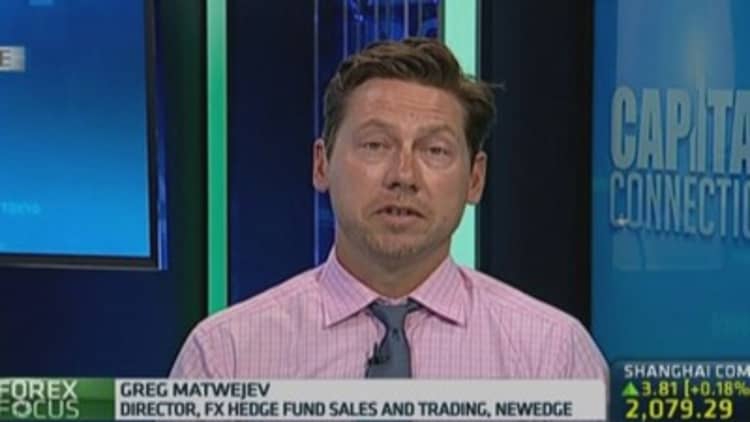The euro's resolve could be starting to crack, as it cleared "psychologically significant" barriers on Tuesday, according to strategists, who now predict a slow grind lower for the currency.
The single currency fell to an 8-month low against the dollar on Wednesday, and hit a 2-year trough against sterling. By close of London trading Wednesday, the euro was trading at $1.346 and 0.79 against the pound, with the latter giving back some gains after a data release from the Bank of England.
The euro's break below the $1.35 mark means it has now broken out of the "recent suffocating range", Kit Juckes, global head of foreign exchange strategy at Societe Generale, said in a research note on Wednesday morning.
Read MoreHow the 'Teflon euro' has stayed resilient
"Technically and psychologically this is significant, and 'should' herald a move towards $1.32, though this risks being pretty slow going," he said.
The euro has performed surprisingly well in recent months, much to the dislike of euro zone exporters and European Central Bank (ECB) President Mario Draghi. A number of traders were also wrong-footed after the ECB unveil a host of stimulus measures in June, and alluded to a quantitative easing program further down the line.
The euro was expected to fall against the dollar in anticipation of additional money in the economy, but this failed to materialize, and dovish words from central bankers in the U.S. also helped the dollar from moving higher.

Since the ECB's announcement, the euro has slipped around 1.4 percent against the dollar. Over the past year, however, it is still close to 3 percent higher against the greenback.
Read MorePortugal banks are the least of the euro zone's problems
Analysts said the euro's strength had been bolstered by investors' use of the currency to buy the debt of struggling euro zone sovereigns, many of which still offer attractive yields in a low-interest-rate environment. Other analysts said central banks could be buying it up for foreign reserve purposes, as an alternative to the dollar.
Kathleen Brooks, a research director at brokerage Forex.com, agreed that the euro could be about to embark on a journey lower.
"We have a glimmer of confidence that decline could be the real deal after the break of $1.3525, which was the first suggestion that the two-year uptrend in EURUSD could be coming to an end," she said in a research note on Tuesday afternoon.
Read MoreTargeting the euro is not a solution: ECB's Praet
Analysts at the Bank of New York Mellon, however, predicted something a little more radical. Looking at statistics regarding the euro's estimated future volatility, they said traders are set for one of the quietest periods in financial-market history in the months ahead.
Senior Currency Strategist Neil Mellor said he believed traders were therefore ill-prepared for any sizeable move -which could potentially be an amplifying force-in-waiting should the euro break lower.
"What appears to be a modest retracement of the (euro) could well transform into something rather more significant as the year progresses," he said in a note on Wednesday.


